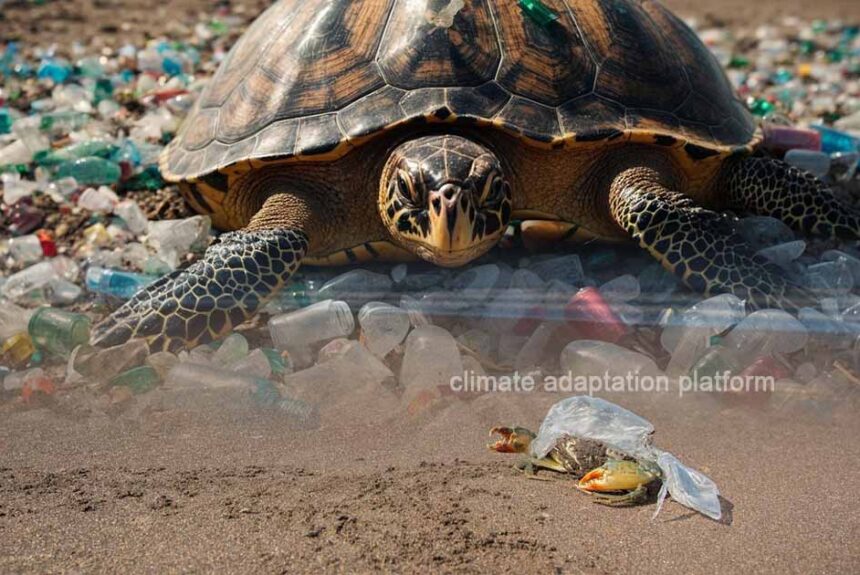Plastic has woven itself into the fabric of our daily lives. What was a great invention that improved society has become a pollution problem. This synthetic organic polymer, derived from fossil fuels including natural gas and petroleum, poses serious threats to all ecosystems—land, freshwater, and marine alike—through rampant plastic pollution.
According to the United Nations Environment Programme, 460 million metric tons of plastic are produced annually. Around 11 metric tons of plastic enter the ocean annually, expected to triple in the next twenty years.
Plastic entering the sea is the largest (85%) and most harmful and persistent percentage of marine litter. Remnants of it have been found in the digestive systems of many water species, including every marine turtle species and nearly half of all surveyed seabird and marine mammal species. The UN Environment Programme estimated the global damage to marine environments from plastic pollution to be a minimum of $13 billion annually.
History of plastic
The first synthetic polymer was created in 1869 by John Wesley Hyatt, motivated by a $10,000 reward a New York company offered for a substitute for ivory. The synthetic polymer proved revolutionary when nature only supplied natural materials like wood, stone, metal, and bone. With the new synthetic polymer, humans can create new materials and save the environment, particularly the elephants for their ivory and tortoises for their shells.
In 1907, Belgian chemist and clever marketeer Leo Baekeland invented the first fully synthetic plastic. The rapidly electrifying United States partly drove the invention of plastic and the need for a synthetic substitute for shellac, a natural electrical insulator.
Hyatt and Baekeland’s achievements prompted significant investments from major corporations in the research and development of new polymers, resulting in the innovation of various plastics. This material liberated society from the limitations imposed by natural resource scarcity.
The expansion of plastics in the United States was particularly notable during World War II when they were transformed into a wide array of products, including nylons, parachutes, ropes, helmet liners, and Plexiglas.
Plastic production in the U.S. surged 300% during the war and continued to grow thereafter. However, the initial optimism surrounding plastics has diminished; what was once celebrated as a groundbreaking invention is increasingly recognised as a pressing environmental issue. The problem of plastic waste in the oceans began to emerge in the 1960s that persists today.
Finding solutions to plastic pollution
Numerous global initiatives have been initiated to prohibit plastics, with 127 countries enacting legislation to regulate plastic bag usage. The World Resources Institute advocates for interventions to mitigate plastic pollution in marine environments. These include:
- Improving wastewater management is crucial, particularly for the 3 billion individuals lacking access to regulated waste disposal facilities;
- Improving stormwater management through implementing filtration systems for stormwater and storm drains and trash collection at river mouths is essential.
- Adopting green chemistry practices and the development of innovative materials is crucial. This includes prohibiting difficult-to-manage substances, limiting hazardous chemicals such as phthalates, promoting materials research, and creating new materials that retain the desirable attributes of plastics while eliminating those that cause damage.
- Practising radical resource efficiency through the reduction of plastic usage. This includes imposing fees on single-use plastics, encouraging voluntary industry standards to minimize fossil-fuel-based plastics, and shifting cultural norms regarding waste generation, consumption, and reuse.
While plastic has a valuable place in improving our lives – for instance, it made possible the development of computers, cell phones, and medical equipment, the problem of plastic pollution is also getting worse. To address the environmental impacts of plastic pollution, scientists are finding ways to make plastic safer and more sustainable. Some are also developing bioplastics made from plants instead of fossil fuels to reduce their environmental impact.
The UN Environment Programme interactive, Our Planet is Choking on Plastic, features the world’s plastic pollution problem.
Data from UNEP shows that poor plastic waste management and the hotspots of plastic pollution are primarily in Southeast Asian countries like China, Indonesia, the Philippines, and Vietnam.
UNEP recommends the steps we can take to stop the worsening plastic pollution problem.
Sources:
History and Future of Plastics. (2024). Science History Institute. Retrieved from https://www.sciencehistory.org/education/classroom-activities/role-playing-games/case-of-plastics/history-and-future-of-plastics/
Plastic pollution. (2024, May). IUCN. Retrieved from https://iucn.org/resources/issues-brief/plastic-pollution
Fast Facts – What is Plastic Pollution? (2023, August 25). Sustainable Development Goals. Retrieved from https://www.un.org/sustainabledevelopment/blog/2023/08/explainer-what-is-plastic-pollution/
Our plant is choking on plastic. (n.d.). UN Environment Programme. Retrieved from https://www.unep.org/interactives/beat-plastic-pollution/
Holloway, L., Jambeck, J., Moss, E., & Dubey, B. (2020, May 26). How to Reduce Plastic and Other Ocean Pollution Simultaneously. WRI. Retrieved from https://www.wri.org/insights/how-reduce-plastic-and-other-ocean-pollution-simultaneously?



Leave a Reply